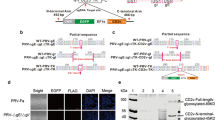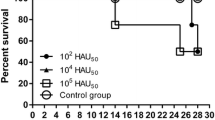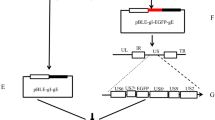Abstract
African swine fever (ASF) is an infectious disease caused by ASF virus (ASFV), which is characterized by high infectivity, rapid onset of disease, and a high mortality rate. Outbreaks of ASFV have caused great economic losses to the global pig industry, and there is a need to develop safe and effective vaccines. In this study, two recombinant pseudorabies virus (PRV) strains, rGXGG-2016-ΔgI/ΔgE-EP364R and rGXGG-2016-ΔgI/ΔgE-B119L, expressing the EP364R and B119L protein, respectively, of ASFV, were constructed by homologous recombination technology. Western blotting and immunofluorescence analysis showed that these foreign proteins were expressed in cells infected with the recombinant strains. The strains showed good genetic stability and proliferative characteristics for 20 passages in BHK-21 cells. Both of these strains were immunogenic in mice, inducing the production of specific antibodies against the expressed ASFV proteins while providing protection against lethal challenge with PRV. Thus, the recombinant strains rGXGG-2016-ΔgI/ΔgE-EP364R and rGXGG-2016-ΔgI/ΔgE-B119L could be used as candidate vaccines for both ASFV and PRV. In addition, our study identifies two potential target genes for the development of safe and efficient ASFV vaccines, provides a reference for the construction of bivalent ASFV and PRV vaccines, and demonstrates the feasibility of developing a live ASFV vector vaccine.





Similar content being viewed by others
Data availability
All data generated or analyzed during this study are included in this published article.
References
Gaudreault NN, Madden DW, Wilson WC, Trujillo JD, Richt JA (2020) African swine fever virus: an emerging DNA arbovirus. Front Vet Sci 7:215. https://doi.org/10.3389/fvets.2020.00215
Inmaculada G, Covadonga A, Linda D, Simon G (2017) African swine fever virus: a review. Viruses 9(5):103
Wang N, Zhao D, Wang J, Zhang Y, Wang M, Gao Y, Li F, Wang J, Bu Z, Rao Z, Wang X (2019) Architecture of African swine fever virus and implications for viral assembly. Science 366:6465
Bao J, Wang Q, Lin P, Liu C, Li L, Wu X, Chi T, Xu T, Ge S, Liu Y, Li J, Wang S, Qu H, Jin T, Wang Z (2019) Genome comparison of African swine fever virus China/2018/Anhui XCGQ strain and related European p72 genotype ii strains. Transbound Emerg Dis 66(3):1167–1176
Zhou X, Li N, Luo Y, Liu Y, Miao F, Chen T, Zhang S, Cao P, Li X, Tian K, Qiu H, Hu R (2018) Emergence of African swine fever in China, 2018. Transbound Emerg Dis 65(6):1482–1484
Li L, Fu J, Li J, Guo S, Chen Q, Zhang Y, Liu Z, Tan C, Chen H, Wang X (2022) African swine fever virus pI215L inhibits type I interferon signaling by targeting interferon regulatory factor 9 for autophagic degradation. J Virol 96(17):e94422. https://doi.org/10.1128/jvi.00944-22
Dodantenna N, Ranathunga L, Chathuranga W, Weerawardhana A, Cha JW, Subasinghe A, Gamage N, Haluwana DK, Kim Y, Jheong W, Poo H, Lee JS (2022) African swine fever virus EP364R and C129R target cyclic GMP-AMP to inhibit the cGAS-STING signaling pathway. J Virol 96(15):e102222. https://doi.org/10.1128/jvi.01022-22
Li YH, Peng JL, Xu ZS, Xiong MG, Wu HN, Wang SY, Li D, Zhu GQ, Ran Y, Wang YY (2023) African swine fever virus cysteine protease ps273R inhibits type I interferon signaling by mediating STAT2 degradation. J Virol 97(3):e194222. https://doi.org/10.1128/jvi.01942-22
Gao Q, Yang Y, Quan W, Zheng J, Luo Y, Wang H, Chen X, Huang Z, Chen X, Xu R, Zhang G, Gong L (2021) The African swine fever virus with MGF360 and MGF505 deleted reduces the apoptosis of porcine alveolar macrophages by inhibiting the NF-kappaB signaling pathway and interleukin-1beta. Vaccines (Basel) 9(11):1371. https://doi.org/10.3390/vaccines9111371
Yang K, Xue Y, Niu T, Li X, Cheng M, Bao M, Zou B, Shi C, Wang J, Yang W, Wang N, Jiang Y, Yang G, Zeng Y, Cao X, Wang C (2022) African swine fever virus MGF505-7R protein interacted with IRF7 and TBK1 to inhibit type I interferon production. Virus Res 322:198931. https://doi.org/10.1016/j.virusres.2022.198931
Lakshminarayan MI, Balaji S, Eugene VK, Aravind L (2006) Evolutionary genomics of nucleo-cytoplasmic large DNA viruses. Virus Res 117(1):156-184
Jancovich JK, Chapman D, Hansen DT, Robida MD, Loskutov A, Craciunescu F, Borovkov A, Kibler K, Goatley L, King K, Netherton CL, Taylor G, Jacobs B, Sykes K, Dixon LK (2018) Immunization of pigs by DNA prime and recombinant vaccinia virus boost to identify and rank African swine fever virus immunogenic and protective proteins. J Virol 92(8):10–1128. https://doi.org/10.1128/JVI.02219-17
Lynnette CG, Ana LR, Raquel P, Hannah G, Gareth LS, Zoe H, Chak-Sum H, María M, Pedro JS, Geraldine T, Linda KD, Christopher LN (2020) A pool of eight virally vectored African swine fever antigens protect pigs against fatal disease. Vaccines 8(2):234
Rodriguez I, Redrejo-Rodriguez M, Rodriguez JM, Alejo A, Salas J, Salas ML (2006) African swine fever virus pB119L protein is a flavin adenine dinucleotide-linked sulfhydryl oxidase. J Virol 80(7):3157–3166. https://doi.org/10.1128/JVI.80.7.3157-3166.2006
Lewis T, Zsak L, Burrage TG, Lu Z, Kutish GF, Neilan JG, Rock DL (2000) An African swine fever virus ERV1-ALR homologue, 9GL, affects virion maturation and viral growth in macrophages and viral virulence in swine. J Virol 74(3):1275–1285. https://doi.org/10.1128/jvi.74.3.1275-1285.2000
O'Donnell V, Holinka LG, Krug PW, Gladue DP, Carlson J, Sanford B, Alfano M, Kramer E, Lu Z, Arzt J, Reese B, ***Carrillo C, Risatti GR, Borca MV (2015) African swine fever virus Georgia 2007 with a deletion of virulence-associated gene 9GL (B119L), when administered at low doses, leads to virus attenuation in swine and induces an effective protection against homologous challenge. J Virol 89(16):8556–8566
Gladue DP, O'Donnell V, Ramirez-Medina E, Rai A, Pruitt S, Vuono EA, Silva E, Velazquez-Salinas L, Borca MV (2020) Deletion of CD2-like (CD2v) and C-type lectin-like (EP153R) genes from African swine fever virus Georgia-∆9GL abrogates its effectiveness as an experimental vaccine. Viruses 12(10):1185. https://doi.org/10.3390/v12101185
O’Donnell V, Holinka LG, Sanford B, Krug PW, Carlson J, Pacheco JM, Reese B, Risatti GR, Gladue DP, Borca MV (2016) African swine fever virus Georgia isolate harboring deletions of 9GL and MGF360/505 genes is highly attenuated in swine but does not confer protection against parental virus challenge. Virus Res 221:8–14. https://doi.org/10.1016/j.virusres.2016.05.014
Vivian O, Guillermo RR, Lauren GH, Peter WK, Jolene C, Lauro VS, Paul AA, Douglas PG, Manuel VB (2017) Simultaneous deletion of the 9GL and UK genes from the African swine fever virus Georgia 2007 isolate offers increased safety and protection against homologous challenge. J Virol 91(1):10–1128
Pomeranz LE, Reynolds AE, Hengartner CJ (2005) Molecular biology of pseudorabies virus: impact on neurovirology and veterinary medicine. Microbiol Mol Biol Rev 69(3):462–500. https://doi.org/10.1128/MMBR.69.3.462-500.2005
Cheung AK (1989) Detection of pseudorabies virus transcripts in trigeminal ganglia of latently infected swine. J Virol 63(7):2908–2913. https://doi.org/10.1128/JVI.63.7.2908-2913.1989
Zheng HH, Fu PF, Chen HY, Wang ZY (2022) Pseudorabies virus: from pathogenesis to prevention strategies. Viruses 14(8):1638. https://doi.org/10.3390/v14081638
Liu Q, Wang X, Xie C, Ding S, Yang H, Guo S, Li J, Qin L, Ban F, Wang D, Wang C, Feng L, Ma H, Wu B, Zhang L, Dong C, Xing L, Zhang J, Chen H, Yan R, Wang X, Li W (2021) A novel human acute encephalitis caused by pseudorabies virus variant strain. Clin Infect Dis 73(11):e3690–e3700. https://doi.org/10.1093/cid/ciaa987
Klupp BG, Hengartner CJ, Mettenleiter TC, Enquist LW (2004) Complete, annotated sequence of the pseudorabies virus genome. J Virol 78(1):424–440
Jiang C, Ma Z, Bai J, Sun Y, Cao M, Wang X, Jiang P, Liu X (2023) Comparison of the protective efficacy between the candidate vaccine Zj01R carrying gE/gI/TK deletion and three commercial vaccines against an emerging pseudorabies virus variant. Vet Microbiol 276:109623. https://doi.org/10.1016/j.vetmic.2022.109623
Zhu L, Yi Y, Xu Z, Cheng L, Tang S, Guo W (2011) Growth, physicochemical properties, and morphogenesis of Chinese wild-type PRV Fa and its gene-deleted mutant strain PRV SA215. Virol J 8:272. https://doi.org/10.1186/1743-422X-8-272
Tang YD, Liu JT, Wang TY, An TQ, Sun MX, Wang SJ, Fang QQ, Hou LL, Tian ZJ, Cai XH (2016) Live attenuated pseudorabies virus developed using the CRISPR/Cas9 system. Virus Res 225:33–39. https://doi.org/10.1016/j.virusres.2016.09.004
Wu T, Hao Z, Guo-Xin L, Fei G, Tong-Ling S, Yan-Jun Z, Hai Y, Yi-Feng J, Ling-Xue Y, Li-Wei L, Ning K, Guang-Zhi T, Ji-Chang L (2020) Recombinant pseudorabies virus expressing E2 of classical swine fever virus (CSFV) protects against both virulent pseudorabies virus and CSFV. Antivir Res 173(C):104652
Zheng HH, Wang LQ, Fu PF, Zheng LL, Chen HY, Liu F (2020) Characterization of a recombinant pseudorabies virus expressing porcine parvovirus VP2 protein and porcine IL-6. Virol J 17(1):19. https://doi.org/10.1186/s12985-020-1292-8
Feng Z, Chen J, Liang W, Chen W, Li Z, Chen Q, Cai S (2020) The recombinant pseudorabies virus expressing African swine fever virus CD2v protein is safe and effective in mice. Virol J 17(1):180. https://doi.org/10.1186/s12985-020-01450-7
Tan L, Yao J, Lei L, Xu K, Liao F, Yang S, Yang L, Shu X, Duan D, Wang A (2022) Emergence of a novel recombinant pseudorabies virus derived from the field virus and its attenuated vaccine in China. Front Vet Sci 9:872002. https://doi.org/10.3389/fvets.2022.872002
Yao L, Hu Q, Zhang C, Ghonaim AH, Cheng Y, Ma H, Yu X, Wang J, Fan X, He Q (2021) Untargeted LC–MS based metabolomic profiling of iPAMs to investigate lipid metabolic pathways alternations induced by different pseudorabies virus strains. Vet Microbiol 256:109041. https://doi.org/10.1016/j.vetmic.2021.109041
Tong W, Liu F, Zheng H, Liang C, Zhou YJ, Jiang YF, Shan TL, Gao F, Li GX, Tong GZ (2015) Emergence of a pseudorabies virus variant with increased virulence to piglets. Vet Microbiol 181(3–4):236–240. https://doi.org/10.1016/j.vetmic.2015.09.021
An TQ, Peng JM, Tian ZJ, Zhao HY, Li N, Liu YM, Chen JZ, Leng CL, Sun Y, Chang D, Tong GZ (2013) Pseudorabies virus variant in Bartha-K61-vaccinated pigs, China. Emerg Infect Dis 19(11):1749–1755. https://doi.org/10.3201/eid1911.130177
Luo Y, Li N, Cong X, Wang CH, Du M, Li L, Zhao B, Yuan J, Liu DD, Li S, Li Y, Sun Y, Qiu HJ (2014) Pathogenicity and genomic characterization of a pseudorabies virus variant isolated from Bartha-K61-vaccinated swine population in China. Vet Microbiol 174(1–2):107–115. https://doi.org/10.1016/j.vetmic.2014.09.003
Yu ZQ, Tong W, Zheng H, Li LW, Li GX, Gao F, Wang T, Liang C, Ye C, Wu JQ, Huang Q, Tong GZ (2017) Variations in glycoprotein B contribute to immunogenic difference between PRV variant JS-2012 and Bartha-K61. Vet Microbiol 208:97–105. https://doi.org/10.1016/j.vetmic.2017.07.019
Ye C, Zhang QZ, Tian ZJ, Zheng H, Zhao K, Liu F, Guo JC, Tong W, Jiang CG, Wang SJ, Shi M, Chang XB, Jiang YF, Peng JM, Zhou YJ, Tang YD, Sun MX, Cai XH, An TQ, Tong GZ (2015) Genomic characterization of emergent pseudorabies virus in China reveals marked sequence divergence: evidence for the existence of two major genotypes. Virology 483:32–43. https://doi.org/10.1016/j.virol.2015.04.013
Nie Z, Zhu S, Wu L, Sun R, Shu J, He Y, Feng H (2023) Progress on innate immune evasion and live attenuated vaccine of pseudorabies virus. Front Microbiol 14:1138016. https://doi.org/10.3389/fmicb.2023.1138016
Ren Q, Ren H, Gu J, Wang J, Jiang L, Gao S (2022) The epidemiological analysis of pseudorabies virus and pathogenicity of the variant strain in Shandong province. Front Vet Sci 9:806824. https://doi.org/10.3389/fvets.2022.806824
Qin Y, Qin S, Huang X, Xu L, Ouyang K, Chen Y, Wei Z, Huang W (2023) Isolation and identification of two novel pseudorabies viruses with natural recombination or TK gene deletion in China. Vet Microbiol 280:109703. https://doi.org/10.1016/j.vetmic.2023.109703
Reed LJ, Muench H (1938) A simple method of estimating fifty per cent endpoints. Am J Epidemiol 27:493–497
Woah (2023) African swine fever (ASF)—situation report 29
Tran XH, Phuong L, Huy NQ, Thuy DT, Nguyen VD, Quang PH, Ngon QV, Rai A, Gay CG, Gladue DP, Borca MV (2022) Evaluation of the safety profile of the ASFV vaccine candidate ASFV-G-∆I177L. Viruses 14(5):896. https://doi.org/10.3390/v14050896
Borca MV, Ramirez-Medina E, Silva E, Vuono E, Rai A, Pruitt S, Holinka LG, Velazquez-Salinas L, Zhu J, Gladue DP (2020) Development of a highly effective African swine fever virus vaccine by deletion of the I177L gene results in sterile immunity against the current epidemic Eurasia strain. J Virol 94(7):10–1128. https://doi.org/10.1128/JVI.02017-19
King K, Chapman D, Argilaguet JM, Fishbourne E, Hutet E, Cariolet R, Hutchings G, Oura CA, Netherton CL, Moffat K, Taylor G, Le Potier MF, Dixon LK, Takamatsu HH (2011) Protection of European domestic pigs from virulent African isolates of African swine fever virus by experimental immunisation. Vaccine 29(28):4593–4600. https://doi.org/10.1016/j.vaccine.2011.04.052
Mulumba-Mfumu LK, Goatley LC, Saegerman C, Takamatsu HH, Dixon LK (2016) Immunization of African indigenous pigs with attenuated genotype I African swine fever virus OURT 88/3 induces protection against challenge with virulent strains of genotype I. Transbound Emerg Dis 63(5):e323–e327. https://doi.org/10.1111/tbed.12303
Cadenas-Fernandez E, Sanchez-Vizcaino JM, van den Born E, Kosowska A, van Kilsdonk E, Fernandez-Pacheco P, Gallardo C, Arias M, Barasona JA (2021) High doses of inactivated African swine fever virus are safe, but do not confer protection against a virulent challenge. Vaccines (Basel) 9(3):242. https://doi.org/10.3390/vaccines9030242
Tamas V, Righi C, Meszaros I, D'Errico F, Olasz F, Casciari C, Zadori Z, Magyar T, Petrini S, Feliziani F (2023) Involvement of the MGF 110-11L gene in the African swine fever replication and virulence. Vaccines (Basel) 11(4):846. https://doi.org/10.3390/vaccines11040846
Lokhandwala S, Waghela SD, Bray J, Martin CL, Sangewar N, Charendoff C, Shetti R, Ashley C, Chen CH, Berghman LR, Mwangi D, Dominowski PJ, Foss DL, Rai S, Vora S, Gabbert L, Burrage TG, Brake D, Neilan J, Mwangi W (2016) Induction of robust immune responses in swine by using a cocktail of adenovirus-vectored African swine fever virus antigens. Clin Vaccine Immunol 23(11):888–900. https://doi.org/10.1128/CVI.00395-16
Goatley LC, Reis AL, Portugal R, Goldswain H, Shimmon GL, Hargreaves Z, Ho CS, Montoya M, Sanchez-Cordon PJ, Taylor G, Dixon LK, Netherton CL (2020) A pool of eight virally vectored African swine fever antigens protect pigs against fatal disease. Vaccines (Basel) 8(2):234. https://doi.org/10.3390/vaccines8020234
Chen X, Li H, Zhu Q, Chen H, Wang Z, Zheng L, Liu F, Wei Z (2022) Serological investigation and genetic characteristics of pseudorabies virus between 2019 and 2021 in Henan province of China. Viruses 14(8):1685. https://doi.org/10.3390/v14081685
Yao J, Li J, Gao L, He Y, Xie J, Zhu P, Zhang Y, Zhang X, Duan L, Yang S, Song C, Shu X (2022) Epidemiological investigation and genetic analysis of pseudorabies*** virus in Yunnan province of China from 2017 to 2021. Viruses 14(5):895. https://doi.org/10.3390/v14050895
Liu Y, Zhang S, Xu Q, Wu J, Zhai X, Li S, Wang J, Ni J, Yuan L, Song X, Zhao B, Zhou Z, Wang C, Yang L (2018) Investigation on pseudorabies prevalence in Chinese swine breeding farms in 2013–2016. Trop Anim Health Prod 50(6):1279–1285. https://doi.org/10.1007/s11250-018-1555-1
Sun L, Tang Y, Yan K, Zhang H (2022) Construction of a quadruple gene-deleted vaccine confers complete protective immunity against emerging PRV variant challenge in piglets. Virol J 19(1):19. https://doi.org/10.1186/s12985-022-01748-8
Babic N, Klupp B, Brack A, Mettenleiter TC, Ugolini G, Flamand A (1996) Deletion of glycoprotein gE reduces the propagation of pseudorabies virus in the nervous system of mice after intranasal inoculation. Virology 219(1):279–284. https://doi.org/10.1006/viro.1996.0247
Yin Y, Xu Z, Liu X, Li P, Yang F, Zhao J, Fan Y, Sun X, Zhu L (2017) A live gI/gE-deleted pseudorabies virus (prv) protects weaned piglets against lethal variant PRV challenge. Virus Genes 53(4):565–572. https://doi.org/10.1007/s11262-017-1454-y
Acknowledgements
The authors thank Dr. Dev Sooranna, Imperial College London, for editing the English text of a draft of this manuscript.
Funding
This study was supported by the National Natural Science Foundation of China (32260875).
Author information
Authors and Affiliations
Contributions
Xin-Mei Geng performed the experiments and wrote the manuscript. Ying-Mu Xi and Xiang-Mei Huang supervised data collection and analysis. Yang-Lin Wang and Xu-Ying Wang were responsible for sample collection. Kang Ouyang, Ying Chen, and Zuzhang Wei checked and finalized the manuscript. Yi-feng Qin and Wei-jian Huang initiated the study, designed the experiments, and supplied the manuscript. All authors contributed to the article and approved the submitted version.
Corresponding authors
Ethics declarations
Conflict of interest
The authors declare that the research was conducted in the absence of any commercial or financial relationships that could be construed as a potential conflict of interest.
Additional information
Handling Editor: William G. Dundon.
Publisher's Note
Springer Nature remains neutral with regard to jurisdictional claims in published maps and institutional affiliations.
Rights and permissions
Springer Nature or its licensor (e.g. a society or other partner) holds exclusive rights to this article under a publishing agreement with the author(s) or other rightsholder(s); author self-archiving of the accepted manuscript version of this article is solely governed by the terms of such publishing agreement and applicable law.
About this article
Cite this article
Geng, XM., Xi, YM., Huang, XM. et al. Construction of and evaluation of the immune response to two recombinant pseudorabies viruses expressing the B119L and EP364R proteins of African swine fever virus. Arch Virol 169, 22 (2024). https://doi.org/10.1007/s00705-023-05935-y
Received:
Accepted:
Published:
DOI: https://doi.org/10.1007/s00705-023-05935-y




